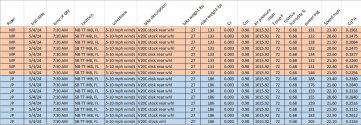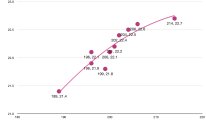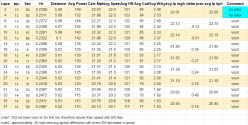Maria and I went out for a 40 mile training ride this morning, including four out-and-back laps on the "Tropical Trail" which is a beautiful road that is only a few meters from the Indian River on the Space Coast of Florida. Maria started out with a stock rear wheel, and I started out with a full disk wheel on the rear. Because it's hard to find a non-drive full disk wheel, we had these specially made to be tubeless-ready, with thru-axle hubs, and disk-brake compatible (we have a small number of these in stock on our warehouse clearance page). After two laps, we switched rear wheels, and did two more laps. I broke down each lap into a northbound (NB) and southbound (SB) segment, so there are 8 eight segments for each of us. I cut out places where we had to use our brakes and stop, just capturing the moving segments, which were each about 4 miles long. I would have preferred a quiet loop course where no brakes were required, but there aren't any around here.
I entered the speed, power, rider/bike weights, road surface, and atmospheric conditions into a spreadsheet and calculated the Cd*A. On average, the Cd*A was 0.0211 lower with the disk wheel. That may not sound like much, but in the 21-23 mph range, that is equal to a benefit of about 0.62 mph. In other words, with the disk wheel, on a flat course and all other things being equal, after one hour of cycling, you would be 1000 meters ahead of your twin riding the stock wheel. Extrapolate that to a 24-hour race, and now you are 24 km ahead.
My V20C has the extra-long chainstay, so I have already moved my feet up into an optimum position since I have a 43.5 inch x-seam. We have not yet begun working on other aero-optimizing techniques (helmets, clothing, handlebars, etc.) so hopefully before November we will work these Cd*A numbers down. A big one I could do is lose weight. I am about 16 lbs. heavier than I was when I raced in RAAM 2017. I had my Cd*A down to about .225 then, which is pretty good for a tall guy. Maria can get hers under .20, which is amazing. I am currently using the stock handlebar, which is very wide. I will switch to a narrower bar (but one that is still comfortable and gives clearance so my thumbs don't quite brush my thighs). I like the Ritchey Comp Evomax handlebar in 44cm. It fits me well and is affordable. I cut about 5 cm from the un-used bar ends (to save weight, reduce drag, and improve clearance when moving the bike around).
Here is the data table from this morning's testing:

I entered the speed, power, rider/bike weights, road surface, and atmospheric conditions into a spreadsheet and calculated the Cd*A. On average, the Cd*A was 0.0211 lower with the disk wheel. That may not sound like much, but in the 21-23 mph range, that is equal to a benefit of about 0.62 mph. In other words, with the disk wheel, on a flat course and all other things being equal, after one hour of cycling, you would be 1000 meters ahead of your twin riding the stock wheel. Extrapolate that to a 24-hour race, and now you are 24 km ahead.
My V20C has the extra-long chainstay, so I have already moved my feet up into an optimum position since I have a 43.5 inch x-seam. We have not yet begun working on other aero-optimizing techniques (helmets, clothing, handlebars, etc.) so hopefully before November we will work these Cd*A numbers down. A big one I could do is lose weight. I am about 16 lbs. heavier than I was when I raced in RAAM 2017. I had my Cd*A down to about .225 then, which is pretty good for a tall guy. Maria can get hers under .20, which is amazing. I am currently using the stock handlebar, which is very wide. I will switch to a narrower bar (but one that is still comfortable and gives clearance so my thumbs don't quite brush my thighs). I like the Ritchey Comp Evomax handlebar in 44cm. It fits me well and is affordable. I cut about 5 cm from the un-used bar ends (to save weight, reduce drag, and improve clearance when moving the bike around).
Here is the data table from this morning's testing:







